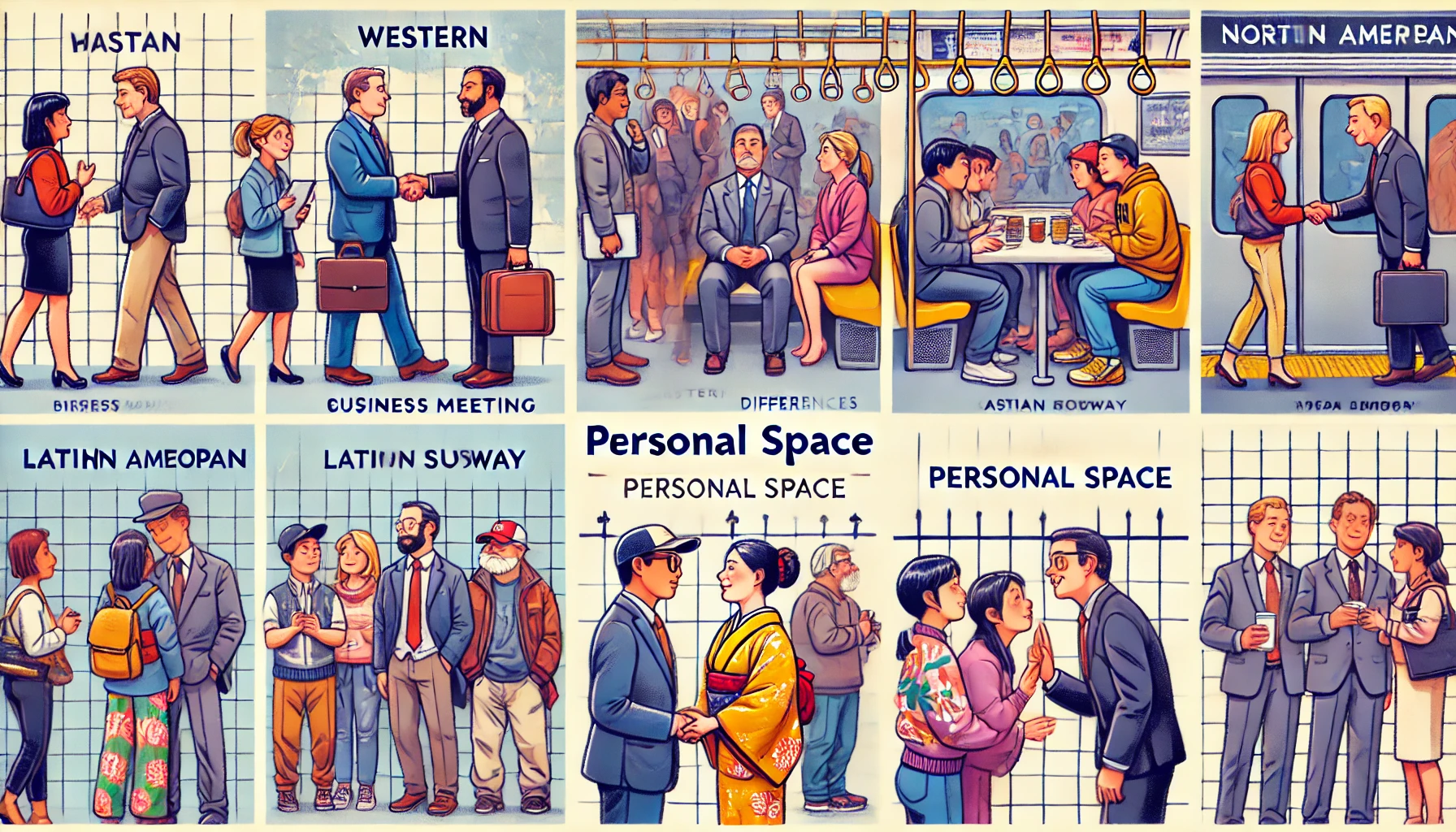Personal space is an invisible bubble that surrounds each of us, defining our comfort levels when interacting with others. While this concept is universal, the size and flexibility of this “bubble” vary significantly across cultures. In some countries, people stand close when talking, while in others, maintaining distance is essential for respectful communication.
Understanding cultural differences in personal space is crucial for travelers, business professionals, and anyone engaging in cross-cultural interactions. This article explores how different societies perceive personal boundaries, the factors that influence spatial preferences, and how to navigate cultural differences in personal space.
1. Understanding Personal Space and Proxemics
The study of personal space and spatial behavior is known as proxemics, a term introduced by anthropologist Edward T. Hall in the 1960s. According to Hall, there are four primary zones of personal space in many Western cultures:
- Intimate Space (0-45 cm / 0-1.5 feet) – Reserved for close relationships like family, romantic partners, and very close friends.
- Personal Space (45 cm – 1.2 m / 1.5-4 feet) – The comfort zone for casual friends and acquaintances.
- Social Space (1.2 – 3.6 m / 4-12 feet) – Used for interactions in workplaces, meetings, and social gatherings.
- Public Space (over 3.6 m / 12+ feet) – The distance maintained in public speeches, lectures, and among strangers.
While these distances apply to Western societies, they are not universal. Different cultures have unique expectations regarding how close or far people should stand when interacting.
2. Cultural Variations in Personal Space
High-Contact Cultures: Close Interactions
In some cultures, physical closeness is a sign of warmth, trust, and engagement. In these societies, people are comfortable with touching, standing close, and making physical contact during conversations.
Examples of high-contact cultures include:
- Latin America (Brazil, Mexico, Argentina, etc.) – People in these countries often greet each other with hugs or kisses on the cheek. Standing close while talking is normal and expected.
- Southern Europe (Spain, Italy, Greece, Portugal) – Physical contact is common, and maintaining close proximity is a sign of friendliness and openness.
- Middle Eastern Countries (Saudi Arabia, Egypt, UAE, etc.) – While gender norms influence interactions, people generally stand closer when speaking, especially in same-gender conversations.
In these cultures, stepping back during a conversation might be perceived as coldness or disinterest.
Low-Contact Cultures: The Need for Space
In contrast, some cultures place a high value on personal boundaries and maintaining distance during interactions. People in these cultures may feel uncomfortable if someone invades their personal space.
Examples of low-contact cultures include:
- Northern Europe (Scandinavia, Germany, UK, Netherlands) – People prefer to maintain a larger physical distance during conversations. Touching and close proximity are generally reserved for family and close friends.
- North America (United States, Canada) – While Americans may be friendly, they generally prefer maintaining at least an arm’s length distance when interacting.
- East Asia (Japan, China, South Korea) – Personal space is highly respected. In places like Japan, bowing is preferred over handshakes, and physical contact between acquaintances is minimal.
In these cultures, standing too close may be interpreted as intrusive or aggressive.
Moderate-Contact Cultures: A Balance Between Distance and Closeness
Some cultures fall somewhere in the middle, allowing for flexibility in personal space depending on the situation.
Examples include:
- Australia and New Zealand – People are generally comfortable with a balance of closeness and distance, depending on the context.
- Central and Eastern Europe (France, Russia, Poland, etc.) – Personal space varies; in formal settings, distance is maintained, but in social settings, people may stand closer.
- India and Southeast Asia (Thailand, Philippines, Indonesia, etc.) – Personal space is respected, but in crowded urban areas, people adapt to standing closer out of necessity.
These cultures tend to adjust their spatial boundaries based on the situation, familiarity, and social norms.
3. Factors That Influence Personal Space Perception
1. Population Density and Urban Living
In densely populated areas, such as Tokyo, New York, or Mumbai, people naturally become more comfortable with reduced personal space. Crowded trains, public markets, and busy streets require individuals to tolerate close proximity.
Conversely, in rural or suburban areas, people tend to have larger personal space bubbles due to lower population density and cultural norms favoring privacy.
2. Gender and Personal Space
Gender expectations influence personal space preferences in many cultures:
- In many Middle Eastern and South Asian cultures, men and women maintain larger distances in public interactions.
- In Western countries, mixed-gender interactions often follow similar spacing rules as same-gender conversations.
- Women generally stand closer to each other than men do in most cultures, as female friendships tend to involve more physical closeness.
3. Age and Generational Differences
Different generations perceive personal space differently:
- Older generations tend to prefer more personal space, especially in professional settings.
- Younger generations are generally more comfortable with reduced personal space due to growing up with digital connectivity and globalization.
- Children often have little understanding of personal boundaries and may invade adults’ personal space without realizing it.
4. Social Context and Formality
The setting of an interaction greatly impacts personal space:
- Business meetings often require a professional distance. In Japan, this means sitting across a table rather than next to each other.
- Casual social gatherings may allow for closer interactions, especially in warm and expressive cultures.
- Public transportation forces people to adjust their comfort levels, as close proximity is unavoidable.
Recognizing these factors helps individuals adapt to different environments and respect cultural expectations.
4. Navigating Cultural Differences in Personal Space
If you travel or work in a multicultural environment, understanding personal space differences can help avoid misunderstandings and improve interactions. Here are some tips:
1. Observe Local Norms
When in a new country or cultural setting, watch how locals interact. If people stand close while talking, follow their lead. If they maintain distance, respect that boundary.
2. Adjust Your Behavior Based on the Situation
- If someone steps back when you approach, avoid stepping closer.
- In business settings, let the other person initiate physical contact (handshakes, pats on the back, etc.).
- In social situations, be mindful of whether others seem comfortable with close interactions.
3. Use Non-Verbal Cues
- If someone crosses their arms or leans away, they may need more space.
- If a person leans in and maintains eye contact, they are likely comfortable with closer proximity.
- Pay attention to body language, as it often signals personal space preferences.
4. Ask When in Doubt
If unsure, it’s always acceptable to ask about comfort levels. Simple questions like, “Is it okay if I stand here?” or “Do you prefer a handshake or a bow?” show cultural awareness and respect.
Conclusion
Personal space is a deeply ingrained cultural concept that varies worldwide. While some cultures embrace closeness, others value maintaining distance. Understanding these differences helps foster better communication, reduce misunderstandings, and create respectful interactions in both social and professional settings.
By observing, adapting, and respecting personal boundaries, we can navigate cultural differences more effectively and build stronger global connections.


